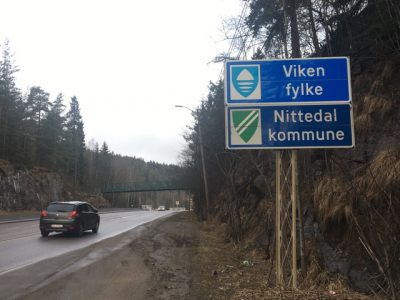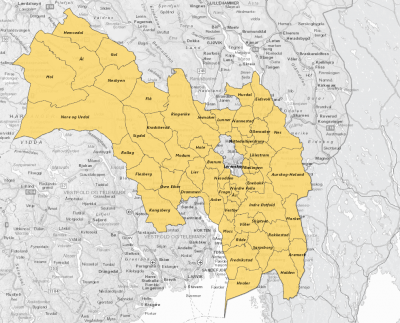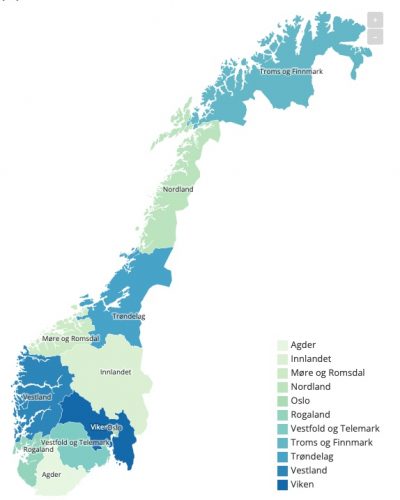Norwegian politicians are finding that breaking up recent forced mergers of counties is so very hard to do. Now, however, a majority of residents in the biggest of the unhappily merged counties, Viken, is keen to split it up again, as are several others.

A new survey conducted by research firm Norstat for media group Amedia and state broadcaster NRK shows that 56 percent of residents responding think Viken should be dismantled and replaced by the three counties (fylker) that made it up: Buskerud, Akershus and Østfold.
Only 27 percent think Viken, controversially created in an efficiency- and money-saving move by the former Conservatives-led government, should be retained. Rebellion against the merged Viken, which sprawls from Halden on the southern border to Sweden and all the way up to the mountains around Hemsedal and westover, is strongest in what used to be Norway’s most southeastern county of Østfold (66 percent, and as high as 74 percent in some Østfold towns).
“I miss Østfold,” one southeastern resident, Nina Ellinor Karlsen, told NRK. “It has to do with where you feel you belong, and that doesn’t always have anything to do with money. We want Østfold back.”

It’s hard to find anyone who identifies with “Viken” since it’s so large and contains so many separate communities with their own identities, local culture and vastly different geography. Residents of coastal communities in the former Østfold have little in common with those living a five-hour drive away in the mountains of Buskerud that extend over parts of the vast plateau known as Hardangervidda.
Those living in unhappily merged counties were relieved when the new Labour-Center coalition government was formed last fall. Both the Labour and Center parties had bashed the mergers throughout the election campaign and promised to allow and even fund de-mergers.
Divorces are thus also pending in the merged county called Innlandet (formed through a forced marriage of Hedmark and Oppland), while Vestfold and Telemark are expected to go their separate ways as well. Troms and Finnmark in Northern Norway were subjected to the most unpopular forced marriage, and were among the first to seek a separation.
The process, however, is proving more expensive and difficult than expected. While Vestfold and Telemark seem to already have agreed on a break-up, and a referendum on the issue looms for residents of Innlandet, the proposed dismantling of Viken has run into some surprising political obstacles. Most everyone thought its break-up was assured, until a few high-ranking Labour Party politicians in the former Akershus County suddenly saw an opportunity to wield more power within a large Viken than they could in a reinstated Akershus.

Some ugly power plays have thus emerged, after the top Labour politicians from Akershus area tried to block a de-merger on the grounds it would be too costly. That infuriated not only the Center Party but also many of their own Labour Party fellows in the former Østfold and Buskerud counties that also were forced into Viken.
Now the Akershus leaders, who include the government ministers Anniken Huitfeldt and Tonje Brenna, seem to have realized their power grab within Viken went too far and alienated not only local colleagues but many state government colleagues as well. Akershus’ board seemed to retreat over the weekend. Now all Labour chapters from the former Akershus, Buskerud and Østfold will meet this coming weekend to vote on whether to retain Viken or break it up into three counties again. If they decide to dismantle Viken, a final vote by Viken’s entire two-year-old county assembly will likely do the same later this month.
It will cost hundreds of millions of kroner to reverse the unpopular mergers but the new anti-consolidation government has promised to cover most of the costs. “If Viken is not split up, the scandal over this whole mess will be complete,” Torleik Svelle, leader of the Center Party’s youth group, told newspaper Dagsavisen on Tuesday. “Then we’d be letting a very small minority (led by Labour ministers Anniken Huitfeldt and Tonje Brenna) roll over an enormous majority in the local municipal chapters, in the Parliament and not least among the people.”
Huitfeldt and Brenna have also been harshly criticized by political commentators including Hege Ulstein, who wrote how they “acted against their government, their own party, lots of local chapters and a majority of Akershus municipalities by working against dissolution of the big county. That’s not how respect for the grass roots and local democracy is supposed to function.”
What’s brewing now is a grass-roots movement within the Labour Party that seems likely to succeed in the drive to break up Viken, widely viewed as an artificial political constellation. Local Labour chapters that, along with government colleagues in the Center Party, promised voters to break up Viken during last year’s election campaign were not pleased when Huitfeldt and Brenna changed their minds and suddenly wanted to keep Viken intact. Now the two have half of the towns and cities within Akershus against them, and will probably back off from the risk creating a deep division within the government, too.
Farther east, in the also-contested merged county of Innlandet, residents will be able to vote in a referendum whether to split up and restore the old counties of Oppland and Hedmark. Everyone aged 16 and over can cast digital ballots from February 10-17. The leader of Innlandet, former Labour government minister Knut Storberget, faces losing his job and not surprisingly wants the large merged county to remain intact. “Hedmark and Oppland are stronger together and need Innlandet,” Storberget said. Here, too, the grass roots seem to disagree.
newsinenglish.no/Nina Berglund

